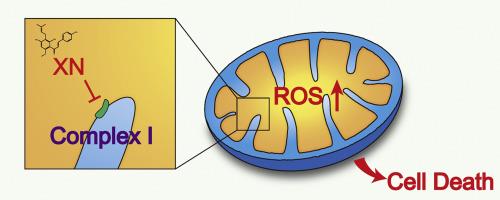Xanthohumol induces generation of reactive oxygen species and triggers apoptosis through inhibition of mitochondrial electron transfer chain complex I |
| |
| Affiliation: | 1. Department of Biochemistry and Molecular Biology III, School of Medicine, Complutense University of Madrid, Madrid, Spain;2. Department of Physiology, School of Medicine, Complutense University of Madrid, Madrid, Spain;3. Department of Physiology (Animal Physiology II), School of Biology, Complutense University of Madrid, Madrid, Spain;1. Department of Cell Biology, Maria Curie-Sklodowska University, Akademicka 19, 20-033 Lublin, Poland;2. Department of Virology and Immunology, Maria Curie-Sklodowska University, Akademicka 19, 20-033 Lublin, Poland;3. Department of Biochemistry and Molecular Biology, Medical University of Lublin, Chodzki 1, 20-093 Lublin, Poland |
| |
| Abstract: | 
Xanthohumol is a prenylflavonoid extracted from hops (Humulus lupulus). It possesses anti-cancer and anti-inflammatory activities in vitro and in vivo, and offers therapeutic benefits for treatment of metabolic syndromes. However, the precise mechanisms underlying its pharmacological effects remain to be elucidated, together with its cellular target. Here, we provide evidence that xanthohumol directly interacts with the mitochondrial electron transfer chain complex I (NADH dehydrogenase), inhibits the oxidative phosphorylation, triggers the production of reactive oxygen species, and induces apoptosis. In addition, we show that as a result of the inhibition of the mitochondrial oxidative phosphorylation, xanthohumol exposure causes a rapid decrease of mitochondrial transmembrane potential. Furthermore, we showed that xanthohumol up-regulates the glycolytic capacity in cells, and thus compensates cellular ATP generation. Dissection of the multiple steps of aerobic respiration by extracellular flux assays revealed that xanthohumol specifically inhibits the activity of mitochondrial complex I, but had little effect on that of complex II, III and IV. Inhibition of complex I by xanthohumol caused the overproduction of reactive oxygen species, which are responsible for the induction of apoptosis in cancer cells. We also found that isoxanthohumol, the structural isomer of xanthohumol, is inactive to cells, suggesting that the reactive 2-hydroxyl group of xanthohumol is crucial for its targeting to the mitochondrial complex I. Together, the remodeling of cell metabolism revealed here has therapeutic potential for the use of xanthohumol. |
| |
| Keywords: | Xanthohumol Mitochondria Oxidative Phosphorylation Reactive Oxygen Species Complex I |
| 本文献已被 ScienceDirect 等数据库收录! |
|

